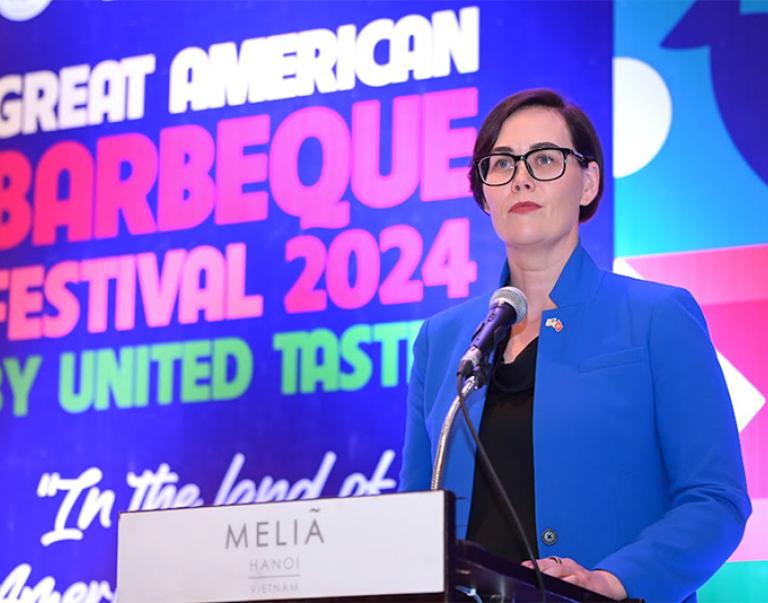WASHINGTON, Oct. 12, 2021 – During a visit to Riverdale Elementary in Riverdale, Maryland today, Agriculture Secretary Tom Vilsack announced that the U.S. Department of Agriculture (USDA) is joining with students, parents, schools, communities, and partners across the nation in recognition of National School Lunch Week, as proclaimed by President Biden. Vilsack said that National School Lunch Week takes on even greater significance this year, as USDA, states, and schools continue to work together to navigate the ever-changing pandemic situation and ensure children receive nutritious school meals.
“This National School Lunch Week, we recognize the importance of school meals to children’s ability to learn and grow, and we honor the hard work and dedication of the school nutrition professionals that make those meals possible, no matter the circumstances,” Vilsack said. “Students’ success in the classroom depends on their ability to access healthy and nutritious meals, which is why USDA is committed to working hand-in-hand with state and local partners to ensure they have the support they need to best serve the children in their care.”
For more photos from today’s event, view the Flickr album of Secretary Vilsack's visit to Riverdale Elementary.
Research shows school meals are the healthiest food children receive in a day, helping the next generation reach their full and healthy potential. Vilsack said both he and the USDA are deeply grateful to schools and partners for their commitment and creativity in making sure children are well fed throughout the pandemic and providing a strong foundation for building back better, together.
Last month, Secretary Vilsack announced $1.5 billion in assistance as part of an all-hands-on-deck effort to support school meal programs facing challenges during the pandemic, including supply chain issues.
Earlier this spring, USDA provided a broad suite of flexibilities to schools for the entire 2021-2022 school year that allow schools to leverage the National School Lunch Program’s Seamless Summer Option (SSO) to serve millions of children nutritious meals at no cost this school year, while still receiving the higher Summer Food Service Program (SFSP) reimbursement rate to help offset increased operating costs. Since then, USDA has been actively engaged in listening to and working with its school meal partners to make sure they have the additional flexibilities, resources, and support they need to operate successful meal programs this school year and in years to come.
Some of these actions include:
- Approving state plans to distribute more than $1.1 billion in relief funds for school meals through the Child Nutrition Emergency Operation Costs Reimbursement Programs to help offset the costs child nutrition program operators incurred during the early months of the pandemic.
- Issuing several additional flexibilities and resources addressing potential and/or evolving challenges, including making sure schools are able to avoid being penalized for not meeting the meal patterns due to supply chain issues and ensuring operators can leverage SFSP to serve meals to children during unanticipated school closures.
- Awarding grants to bolster school meal programs such as Child Nutrition Non-Competitive Technology Innovation Grants, providing more than $37 million to 50 states and territories for improving IT systems; School Breakfast Program Expansion Grants, providing $8.2 million to five states and territories for expanding participation in school breakfast; and Team Nutrition Training Grants for School Meal Recipe Development, providing $5.5 million to 21 states to help schools provide meals using local foods and preparation practices.
- Publishing a variety of new educational resources to help schools plan and serve meals, including a new set – Planning for a Dynamic School Environment – aimed at helping school nutrition professionals successfully leverage current flexibilities.
- Partnering with schools to make them aware of the options already available to them should they face supply chain issues – such as emergency procurement, higher meal reimbursement rates, and waivers of certain meal standard requirements – so they can continue to serve children nutritious meals.
Also this month, USDA is joining in the celebration of Farm to School Month, which recognizes efforts to bring local foods into schools and onto students' trays.
“Farm to school programs can help address pressing needs across the country – from increasing sustainability to boosting local economies – while also offering opportunities for fun and learning for our nation’s school children. A win-win for all involved,” said Vilsack.
The 2019 Farm to School Census found that in school year 2018 - 2019, schools purchased nearly $1.3 billion in local foods, investing back into their communities. This summer, USDA awarded more than $12 million in Farm to School Grants to 177 grantees, the largest cohort of Farm to School Grantees to date.
USDA touches the lives of all Americans each day in so many positive ways. Under the Biden-Harris Administration, USDA is transforming America’s food system with a greater focus on more resilient local and regional food production, fairer markets for all producers, ensuring access to safe, healthy and nutritious food in all communities, building new markets and streams of income for farmers and producers using climate smart food and forestry practices, making historic investments in infrastructure and clean energy capabilities in rural America, and committing to equity across the Department by removing systemic barriers and building a workforce more representative of America. To learn more, visit www.usda.gov.
#
USDA is an equal opportunity provider, employer, and lender.





